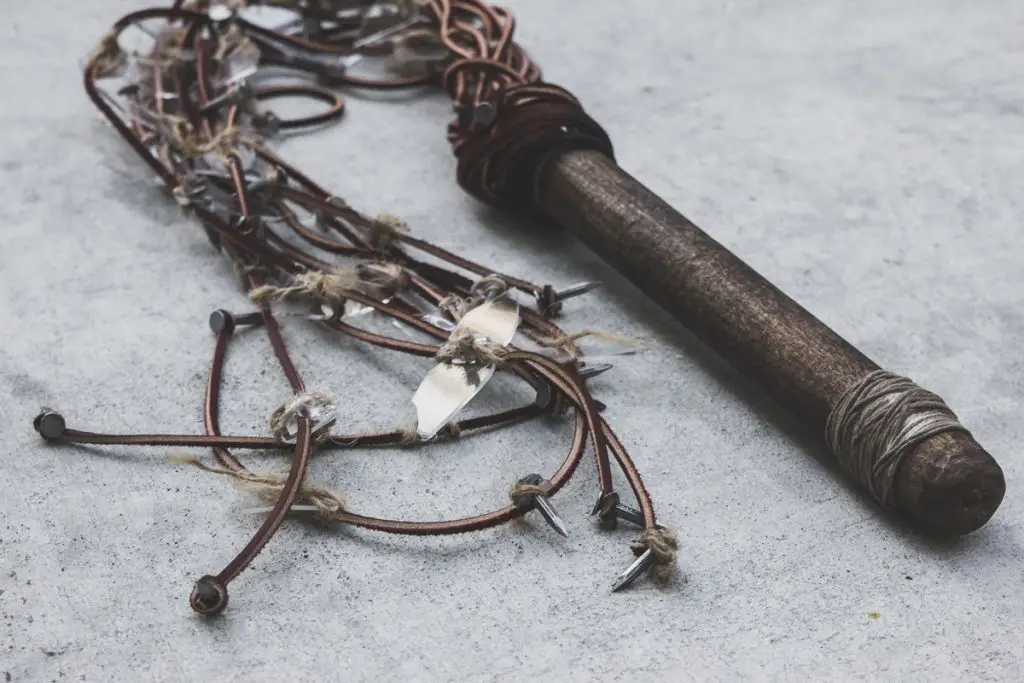“Surely He has borne our griefs and carried our sorrows; yet we esteemed Him stricken, smitten by God, and afflicted. But He was wounded for our transgressions, He was bruised for our iniquities; the chastisement for our peace was upon Him, and by His stripes we are healed” (Isaiah 53:4–5).
“. . . and scourged Him . . .”—John 19:1
Just three words . . . the mind absorbs them in a second and passes to the next sentence. The Bible gives no further explanation. There is no parenthetical statement or footnote explaining what it means. Most of us read over it for years without really contemplating that word . . . scourged. It was somehow a part of the crucifixion. Maybe we heard a preacher say it was some sort of a whipping. Oh, but it was so much more.
Governor Pilate knew the Jews delivered Jesus out of envy (Matthew 27:18), and that He had committed no real crime, certainly not one worthy of death (Luke 23:15). This cagey politician also knew that something had to be done. These folks were too worked up to go home without any action, so he decided a scourging might satisfy their lust for vengeance (John 19:1, cf. 19:5).
Definition and limitations
These were not civilized people by modern standards. Today’s Humane Society would not allow a dog to be treated the way our Lord was.
An examination under scourging (Acts 22:24, 29) was a legal preliminary to every Roman execution.
This brutal flogging was called the “little death” and preceded the “big death” (crucifixion). Only women, Roman senators, and soldiers (except deserters) were exempt. History tells us that a criminal was flogged either by two soldiers (lictors) or by one who alternated positions.
Under Hebrew law, a penalty was limited to forty blows (Deuteronomy 25:3), so they normally stopped at thirty-nine in case they miscounted. The Romans imposed no such numerical limitation. A scourging’s severity depended entirely on the lictor’s disposition. The only rule for the lictor who scourged a man about to be crucified was that he was to expire on the cross—not at the stake. Thus he tried to bring his victim to the very verge of death without crossing that threshold.
Instruments
The scourging post was usually about two feet high. A criminal’s wrists were strapped to an iron ring that projected from two sides near the top. Sometimes the victim’s arms were stretched above his head and fastened to a beam. The usual instrument was a short-handled whip (flagrum, flagellum) with several single or braided thongs of variable lengths, on which sharp pieces of sheep bones were tied at intervals. Sometimes the whip instead was made of several thin, iron chains which ended in small weights.
Preparation
Clothing was stripped so the prisoner stood naked, or at the most with a loincloth. (Is it any wonder the Bible says, “Who for the joy that was set before Him endured the cross, despising the shame . . .”? [Hebrews 12:2].) The man’s wrists were tightly fixed to the iron rings. He was stretched, face down, with his feet pointed away from the post (or in the case of the beam, he was hoisted vertically). In both cases, the shoulder blades were thus positioned to provide little protection for the underlying flesh. The tension of awaiting the first blow was cruel. The body was rigid. The muscles knotted in tormenting cramps. Color drained from the cheeks. Lips were drawn tight against the teeth.
Scourging
Then it came . . . the whistle of the whip and the dull thud as it made contact with flesh. Then it came . . . the burning sensation and the first trickle of blood. Then it came again and again, more rapidly, blow after blow. Then it came with seemingly unbearable agony, as the naked back, neck, sometimes face, chest (as the whip was allowed to encircle the body), buttocks, and legs were repeatedly struck. At first, it caused deep contusions (bruising). Then, as the lictor continued his well-practiced procedure, the thongs, sheep bones, chains, and weights cut into the skin, subcutaneous tissue, and even muscle.
After a while, the victim’s body was said to twitch like a beheaded chicken. The lacerations often tore into the underlying skeletal muscles and produced quivering ribbons of bleeding flesh. As V. P. Black put it, “They beat Him until His shoulder blades looked like two whitecaps on an ocean of blood.” The victim lost all consciousness to anything other than the blinding, burning pain as the cruel whip whistled and cut, whistled and cut. A scourging was the literal equivalent of being flayed alive. It hurt so much that men were known to bite their tongues in two during the
beatings.
The Results
After what seemed like an eternity to the victim and those who loved Him, His limp body was finally taken down from the post or beam. As was the custom, His wounds were washed but not otherwise medicated. The pain and blood loss caused by scourging generally led to circulatory shock. Moreover, hematidrosis (the “bloody sweat” likely experienced in the Garden) would have rendered His skin tender. Also remember that Jesus had gone without food, water, and sleep for fifteen to thirty hours, and that He had been physically and mentally abused during the night.
Thus, Jesus must have been in a weak state by this time. Dr. Joe Clements ventures the opinion that, by modern-day criteria, if at that time Jesus had been admitted to a hospital, He would have been put into intensive or critical care (Mark 15:15, 20). The severity of this condition usually predetermined that the victim would not survive a long time on the cross.
Adding insult to injury
In this case, Jesus’ clothes were put back on the massacred back. Imagine how the seamless garment must have soaked up that precious blood. How uncomfortable it was to have that rough material scratch against His open wounds! As the blood began to clot, His clothing became stiff and dry.
The Roman soldiers, amused that this weakened man had claimed to be a king, began to mock Him. One of them fashioned a robe out of some purple material (or perhaps used the one Herod had used earlier); another ran out to a thorn bush and gathered some prickly limbs and formed them into a tight, pointed circle; another found a rod or stout stick to use as a scepter. Just about the time His bleeding stopped, they ripped His clothes off and placed the robe on Him (thus opening the wounds again). Imagine how that must have hurt! Pulling a Band-Aid from a small cut that has stuck to the gauze is painful; the deep wounds inflicted on Jesus were much worse!
One soldier grabbed His head and forced the thorns down over His scalp. Think of the sharp thorns piercing His skin in dozens of places. Another took the reed and hit Him over the head, thus driving the thorns in more deeply. How He must have hurt! How He must have bled! Since even a small cut to the head bleeds profusely (because so much blood goes continuously to the brain), picture how the blood must have run down His face, into His eyes, nostrils, and mouth, dripping onto His clothes.
The soldiers finally had all the fun they wanted with Him and took Him back to Pilate. Pilate then presented Him to the people.
Picture, if you can, Pilate presenting this purple-clad Man with a scepter dangling from His hand and a bloody crown on His head for these sick people to see.
Pilate said simply, “Behold the Man!” (John 19:5). He must have thought that surely this would satisfy their hatred. Surely they would say, “You’ve done enough. Let Him go.” But he underestimated them. They were no more satisfied than a shark that gets the first scent of blood. They wanted more. They wanted murder.
Why did Jesus go through this? He didn’t have to. He could have gone back to heaven in a chariot of fire. Why, then? Because He wanted to save us. Are you saved? Have you responded to His sacrifice? If not, then so far as you are concerned, He went through all this for nothing. He still invites, “He who believes and is baptized will be saved; but he who does not believe will be condemned” (Mark 16:16).



